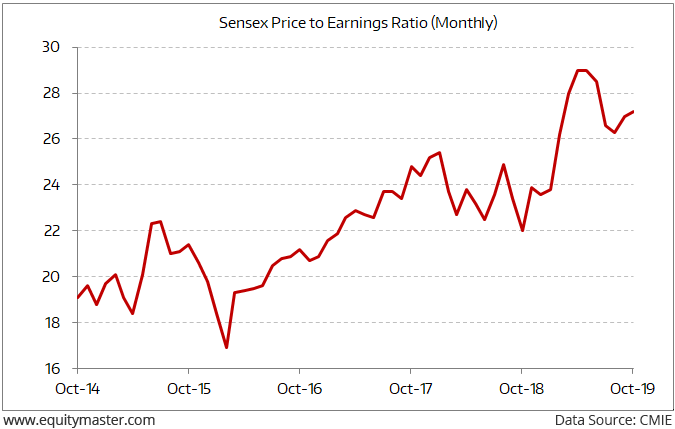Investment in securities market are subject to market risks. Read all the related documents carefully before investing
Grab Our Small Cap Recommendation
Service at a 60% Discount
- Home
- Todays Market
- Indian Stock Market News December 26, 2019
Indian Stock Markets Open Flat; Telecom and IT Stocks Lag Thu, 26 Dec 09:30 am
Asian stock markets mostly edged higher today morning following the Christmas Day. Shanghai composite was up about 0.3%. The Nikkei 225 was 0.4% higher in morning trade.
Back home, India share markets opened flat. The BSE Sensex is trading down by 13 points while the NSE Nifty is trading down by 6 points. The BSE Mid Cap index opened flat, while BSE Small Cap index opened the day up 0.2%.
Sectoral indices have opened the day on a mixed note with consumer durables stocks and FMCG stocks witnessing buying interest. Telecom stocks and IT stocks are trading in red.
Speaking of the Indian stock markets, how expensive is the Sensex? What has the trend been in recent years?
It would be interesting to see how the valuation of the index has moved over the last five years.
The chart below maps the price to earnings ratio of the Sensex from October 2014 to now.
How Pricey Is the Sensex Now?
Here's what Ankit Shah wrote about this in one of the editions of The 5 Minute WrapUp...
- It is worth noting that the Sensex has gained 44% over the last five years, compounding at an annual rate of 7.6% (excluding dividends).
Not quite impressive.
During the same period, the Sensex price to earnings ratio has mostly been in a rising trend, except some intermittent declines.
Between October 2014 and now, the gain in the Sensex price to earnings ratio is 42%. That means that the gains in the index have mostly come from expansion in the valuation multiple, and just meagerly from increases in earnings.
So, before taking the current market bullishness for granted, do weigh in the fact that the Sensex is quite expensively priced.
Moving on, the rupee is currently trading at 71.27 against the US$.
The rupee depreciated by 9 paise to close at 71.27 against the US dollar on Tuesday amid heavy selling in domestic equities and steady rise in crude oil prices.
Reportedly, the rupee traded in a narrow range but was weighed down in the latter half of the session after reports emerged that the government might not be able to meet its disinvestment target.
At the interbank foreign exchange market, the domestic currency opened weak at 71.22 and later fluctuated between a high of 71.15 and a low of 71.29.
Speaking of currencies, Vijay Bhambwani, editor of Weekly Cash Alerts, tells you the main reasons why not to trade commodities and currencies the same way you would trade equities. Here's an excerpt of what he wrote...
- Currencies are traded in pairs and the most liquid is the USDINR. Currencies are traded in four decimal points just as bonds are. The international derivative trader's association has indicated that forex may be traded in 6 decimals in the coming few years.
It takes months sometimes for the currency pair to pass the next round figure, say from 70 to 71.
Can you really trade commodities and currencies alike or for that matter, equities and currencies alike? Definitely not!
To know more, you can read Vijay's entire article here: Is Trading in Equities, Commodities, and Currencies the Same?
Moving on the news from oil & gas sector. Saudi Aramco said on Wednesday a new agreement between Saudi Arabia and Kuwait paves the way for the resumption of oil production in the Neutral (partitioned) Zone shared by the two countries.
Saudi Minister of Energy Prince Abdulaziz bin Salman and Kuwaiti Foreign Minister Sheikh Ahmad Nasser al-Mohammad al-Sabah signed an agreement and a memorandum of understanding in Kuwait, the reports noted.
The two OPEC members halted production at the jointly operated Khafji and Wafra fields, which together produce some 500,000 barrels of oil a day (bpd) or up to 0.5% of the world's oil supply, in 2014 and 2015, respectively.
With lots going in oil front, where do you think are oil prices headed? And what does it mean for the Indian markets?
Well, India's no.1 trader, Vijay Bhambwani shares his insights and updates on his YouTube channel regularly.
In his latest video, he talks about how you can hedge against the rising crude oil prices and also gives a perspective as to what's actually happening in this space.
Tune in...
To know what's moving the Indian stock markets today, check out the most recent share market updates here.
For information on how to pick stocks that have the potential to deliver big returns, download our special report now!
Read the latest Market Commentary



Equitymaster requests your view! Post a comment on "Indian Stock Markets Open Flat; Telecom and IT Stocks Lag". Click here!
Comments are moderated by Equitymaster, in accordance with the Terms of Use, and may not appear
on this article until they have been reviewed and deemed appropriate for posting.
In the meantime, you may want to share this article with your friends!